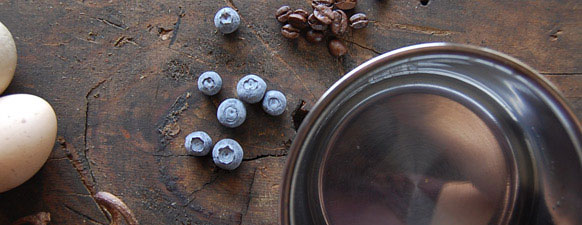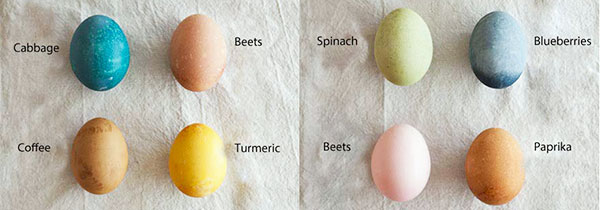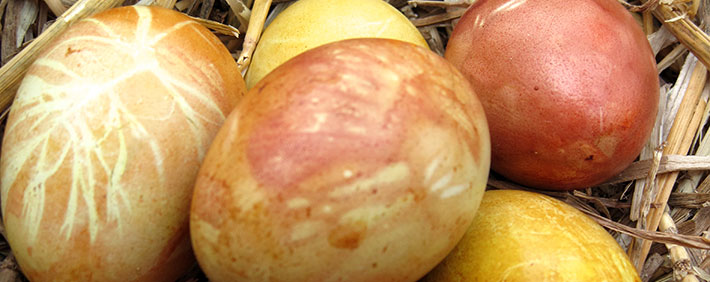Home Decor
Easter Weekend
We’re off to the farm for Easter weekend and it got me thinking about some of the activities that we have put together for the youngsters (and oldsters as it turned out). One of our favorites for years was the Annual Easter Poem Contest! For this event we asked everyone to write a short poem around what Easter means to him or her. The collection over the years is a treasure trove of humorous, insightful and just plain crazy thoughts from all of the family. We had each person read their poem to the group and then at the end the group determined the winner. Prizes were of course part of the program!
Another fun event was the collective DECORATING OF THE EGGS CONTEST! Here too, the creativity (or lack of ) was very, very interesting. And that got me thinking about something a friend of ours was doing in her family, and that was dyeing eggs the natural way using common ingredients from inside and outside the house.
So here are some instructions for using non-toxic, kid friendly, healthy and fun way’s to make your own Easter egg dyes. It might seem a little labor intensive but most of it is in the preparation stage and it’s certainly worth it. You actually avoid the whole “holding and dipping thing” that kids generally find tiresome. The best parts for them are collecting the leaves and flowers and then unwrapping the finished eggs. The rest is up to you!

1. Prepare your dyes. You only need to use a few raw ingredients:
Raw beets for light red
Yellow onion skins for rich rust brown color (redder if you use a combination of yellow and red onions)
Red Cabbage for a blue gray color
Spinach for green (the more spinach the darker the color)
Turmeric Powder for a deep orange/yellow (about 4 tablespoons per pot)
To dye your eggs BLUE: 2 cups chopped purple cabbage, 2 cups water, 1 tablespoon salt, 1 tablespoon vinegar
To dye your eggs GREY-BLUE: -2-3 cups blueberries -2 cups water , 1 tablespoon salt , 1 tablespoon vinegar
To dye your eggs PINK: 1 beet, chopped , 2 cups water , 1 tablespoon salt , 1 tablespoon vinegar
To dye your eggs BROWN: 2 cups of strongly brewed coffee , 1 tablespoon salt , 1 tablespoon vinegar
To dye your eggs ORANGE: 1-2 tablespoons paprika , 2 cups water , 1 tablespoon salt , 1 tablespoon vinegar
To dye your eggs YELLOW: -1-2 tablespoons turmeric , 2 cups water , 1 tablespoon salt , 1 tablespoon vinegar
To dye your eggs GREEN: 3 cups chopped spinach , 2 cups water , 1 tablespoon salt , 1 tablespoon vinegar
Don’t limit yourself to only the above, experiment with others like green apple peels, orange or lemon peels, frozen blueberries, etc.
With these you can combine the dyes in different amounts to make just about any color in the rainbow.

2. Boil the ingredients in a covered pot for about 30 minutes, set aside and cool. When cool, strain into a bowl, pressing the liquid out of the solids, and then return the liquid to the original rinsed pot. Discard the solid material.
3. Gather up the kids and take them outside (don’t leave them there!) and have them collect a variety of leaves and blossoms, ones that are small enough to fit on an egg. The more defined the leaf or bloom the better…dandelions don’t work as well as daisies for example.
4. Get some old pantyhose and cut them into 4” strips. Place your leaves and/or flowers on an egg (some might stick better if you dip them in water first) then pull the pantyhose tightly around the egg, making sure everything is in place and tie it off with a twist tie or string. Trim off the excess hose.
5. Bring your dyes to a gentle boil and add 3-4 tablespoons of vinegar to each one. Then gently lower your eggs into whichever color you want, making sure that the dye covers the egg completely. If not just add enough water to cover the egg. Boil the eggs for about 30 minutes then set aside to cool. The longer you leave them in the dyes, the deeper the colors will be. Or, you can hard boil the white eggs before dyeing and skip the 30 minutes. If you do decide to do this make sure you let them cool before using.

6. Undo the ties and let the kids slip the pantyhose, flowers, and leaves off the eggs. If you want the eggs to be shiny, take a paper towel with a bit of oil on it and gently rub each egg.
Here are some general guidelines:
- Make the individual color dyes in different stainless steel or enamel saucepans.
- Strain the dye mixtures through cheesecloth or a fine strainer for a uniform color; or for mottled, tie-dye, or a spotty effect leave the ingredients in the pan with the cooked beets, onion skins, or blueberries, and put the eggs directly in the pan to soak with the cooked ingredients.
- The longer you soak the eggs the deeper the color will be.
- Combine the different dyes in coffee cups to get different colors.
- To get special effects: dip one half of the egg in one color, the other half in another color. Or use a white crayon on the boiled egg to make circles, or your initials, etc., and then dye the egg.
- For more vibrant colors, place sealed containers of natural dyes in the refrigerator and let the cooked eggs soak overnight. Adding vinegar to the boiling water will also help make the colors brighter. (One exception is with onion skins; do not add vinegar to the onion skins.)

That’s it! You’ve shown the kids that you can do amazing projects just by going out and finding things in nature, and that not everything has to come from the store or be electronic, or digital, or handheld, or whatever!
Happy Easter!


